Sámi People
The Sámi people are indigenous people living in the north of Europe. Sámi communities exist in northern Norway (60,000-100,000), Sweden (15,000-25,000), Finland (6,400) and on Russian Kola peninsula (2,000).
Sámi people are often called Lapps or Laplanders. But, they do not like it at all. They find it pejorative. Sámi call themselves Sámit (the Sámis) or Sápmelaš (of Sámi kin).
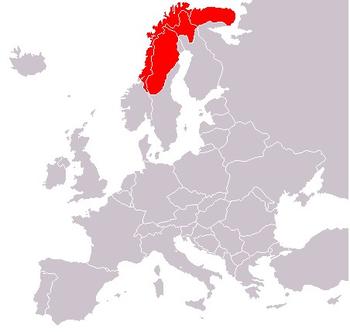 Sápmi region - homeland of the Sámi people
Sápmi region - homeland of the Sámi people
Sámi call the region they live in Sápmi. The Sápmi region has an area of 388,350 square kilometers. Sápmi includes the following counties and provinces. Finnmark, Nord-Trøndelag, Nordland and Troms county in Norway. Dalarnas Län, Jämtlands Län, Norrbottens Län and Västerbottens Län county in Sweden. Lapland province in Finland and Murmansk oblast in Russia.
It has to be mentioned that many Sámi people nowadays live in big cities outside of Sápmi. Also there are about 30,000 people who are Sámi or have Sámi ancestors living in North America.
Most Sámi people do not speak Sámi language (Sàmigiella) or any of its several dialects. The Northern Sámi is the dialect with some 15,000 speakers. Other dialects are Lule Sámi, Kildin Sámi, Inari Sámi, Skolt Sámi, Southern Sámi, Ter Sámi, Ume Sámi and Pite Sámi.
Large majority of Sámi people are Christians – Lutherans in Norway, Sweden and Finland or Orthodox Christians in parts of Finland and in Russia. Shamanism in its traditional form does not exist anymore.
The national anthem of Sápmi is "Sámi soga lávlla" (Song of the Sàmi people). This poem written in 1906 by Sámi teacher and politician Isak Saba (1875-1921). It got the status of national anthem in 1986.
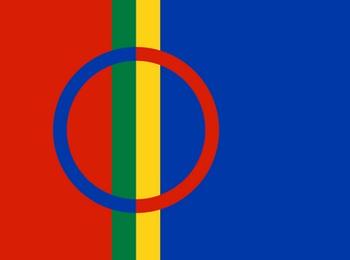 Sámi flag
Sámi flag
The national holiday of Sámi people is the Sámi National Day. It is celebrated on the 6th February. On this day in 1917 the first Sámi congress was organized in Norwegian city of Trondheim. Norwegian and Swedish Sámi people got united in trying to find the solution for their common problems.
Today there is not single Sámi governing body, parliament. There are Sámi parliaments in Finland (1973), Norway (1989) and Sweden (1993).
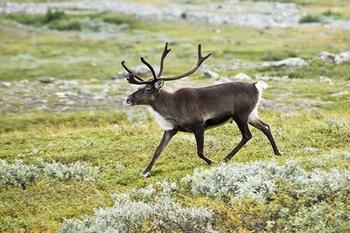 Reindeer (Rangifer tarandus)
Reindeer (Rangifer tarandus)
The reindeer (Rangifer tarandus) is very important for the Sámi people. They are raised for their meat, hides, antlers, milk and transportation.
Apart from reindeer meat Sámi dishes also include sheep and moose meat. Other ingredients in Sámi cuisine are fish, potatoes, beet, angelica, mushrooms, berries and various herbs. Reindeer fat is commonly used instead of butter or milk.
Some of the most popular Sámi dishes are soup Bierggojubttsa, salted fish Sállteguolle and flat bread Gáhkko.
The animal skin was used for making traditional coneshaped tents called laitok (lavvu). Today most tents are made of fabric bought in shops. Shoes and clothes are still traditionally made of reindeer skin. Reindeers are not kept in captivity. They usually roam free on pasture grounds. Reindeer herders migrate with their animals.
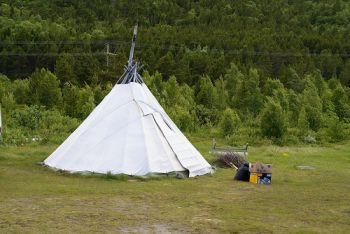 Laitok
Laitok
Sámi people have their own handicrafts or Duodji, as they call them. They made knives, cases, bags, wooden cups, pieces of clothes. Different materials were used. Men used wood, antlers and other Reindeer bones. Women used leather and roots.
One example of Duodji handicrafts is Kuksa. It is a drinking cup made of carved birch burl (bur or burr). The burl is kind of deformation that appears on some trees.
Like so many other nations, Sámi people have their own colours. They are red, green, blue and yellow.
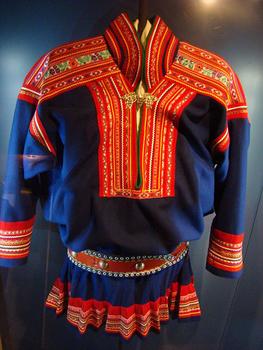 Gákti or kolt
Gákti or kolt
The traditional costume worn by Sámis is called gákti or kolt. It is worn on weddings, funerals, religious festivities and but also during everyday work. To make a gákti people use leather, sinews, and wool. These are the most common materials but sometimes silk and velvet are used too.
Gáktis differ from community to community. Let's take for example the length of gákti. In southern parts of Sápmi is longer than the one in the north of the region.
The colours, patterns and the jewellery present on the gákti have deeper meaning. They can tell if the person is married and where from is the person wearing it. Gákti worn by men is a bit shorter than the one worn by Sámi women.
The gákti can be worn with a beautifully decorated belt, silver jewellery, traditional leather boots and a silk scarf.
The shape of buttons on belt tells if the person is married on not. Square buttons mean that the person is married. Single people wear belt with round buttons.
If the divorced man continues to wear the gákti made by his ex-wife it is believed that he still loves her.
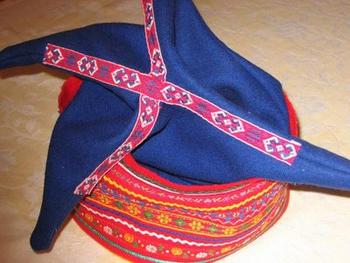 Four Winds hat
Four Winds hat
Sámi people often wear their traditional Four Winds hat or "čiehgahpir". The hat has two parts. First is central, blue one with four-cornered star on top of the hat. The top has red and yellow decorations. The second is red band with beautiful patterns. The same as on gákti, patterns on the hat differ from community to community.
Sámi have their own special way of singing called the joik (jojk, juoigan). Joik is traditionally sung a cappella, meaning without music that accompanies the singing. Nowadys, there are joiks performed with musical instruments too. Themes present in joiks are animals, people, special occasions in life. There are two more types of Sámi singing. They are known as lavlu (laavloe) and vuelie.
Throughout the year there are numerous Sámi cultural festivals. In Norway there is Riddu Riđđu. It is a music festival organized in Olmmaivaggi (Manndalen). Also in Norway there are famous Easter festivals in Kautokeino and Karasjok organized before the spring reindeer migration to the coastal region.
Stállo (stalu) is a popular Sámi mythological character. He can appear in various forms. He can turn into human beings, animals or plants. To make people lost stállo can even change the appearance of the landscape. He is rich and very clever. In Sámi folk stories people describe ways how to cheat the stállo.
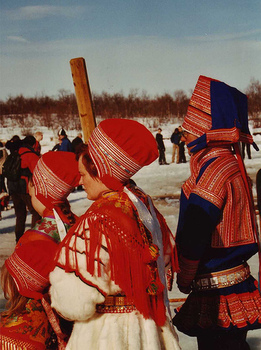 Sámi family
Sámi family
Let's finish this article about Sámi people at the wedding in Karasjok, Norway. Both bride and groom wear gákti or as locals would say "kofta". The bride wears several layers of scarfs and up to 20 silver brooches. She also puts a bridal crown with long silk ribbons attached on top of the traditional Sámi hat. The groom wears long white scarf put as a cross over his chest.
The bridal procession is very important part of the wedding. The procession includes bride and groom, couples who got married in past few years and couples who are still not married. The bride and groom walk as the fourth couple in the procession. They choose three couples who walk in front of them. The couple behind bride and groom are the groom mate and the bridesmaid. Other couples follow.
The procession walks from bride's or groom's home to church and later to the place where the wedding reception is held.